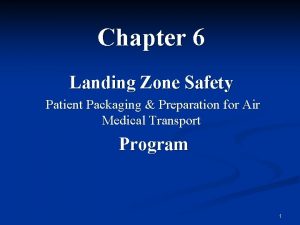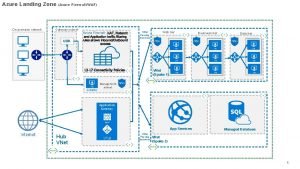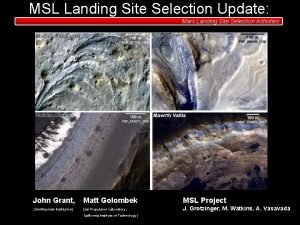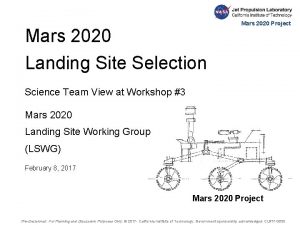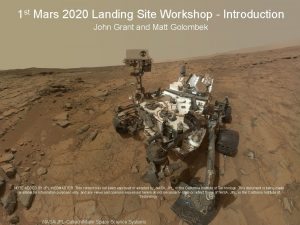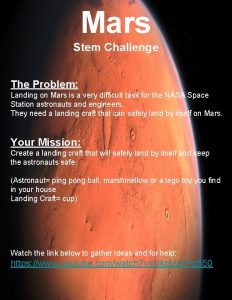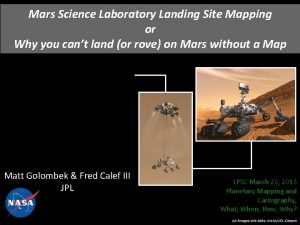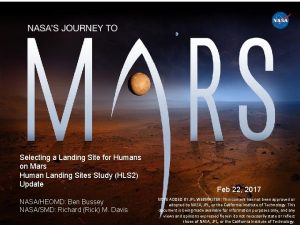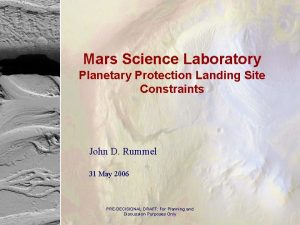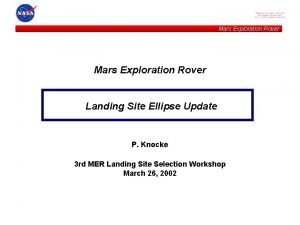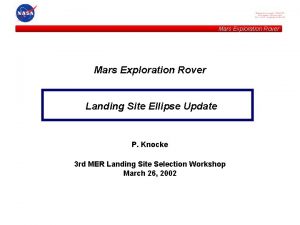Mars 2020 Landing Site Workshop Magnetic Considerations NOTE
















- Slides: 16

Mars 2020 Landing Site Workshop: Magnetic Considerations NOTE ADDED BY JPL WEBMASTER: This content has not been approved or adopted by NASA, JPL, or the California Institute of Technology. This document is being made available for information purposes only, and any views and opinions expressed herein do not necessarily state or reflect those of NASA, JPL, or the California Institute of Technology. 1 Rob Lillis 1 and Ben Weiss 2 MEPAG Investigation B 2. 3 • The collection of high-precision, high-resolution global, regional, and local magnetic measurements, calibration of the ages of surfaces, and measurements of the magnetic properties of samples would now be required. • Additionally required is high-resolution (spatial and field strength) mapping of the magnetic field and determination of the crustal mineralogy (particularly the magnetic carriers), geothermal gradient, and magnetization of geologic units. 2

Value of Noachian, magnetized, oriented bedrock samples Ancient dynamo: • Intensity vs time – Interior Evolution – Climate Evolution • Direction vs time – True polar wander – Dynamo processes How do the candidate sites match up?

Gusev Crater: magnetic crust but no exposed early Noachian bedrock 3

Gusev Crater: magnetic crust but no exposed early Noachian bedrock 4

Eberswalde & Holden: maybe magnetized early Noachian megabreccia 5

Eberswalde & Holden: maybe magnetized early Noachian megabreccia 6

Mawrth Vallis: moderate-to-strong crustal fields & layered in-place Noachian bedrock. 7

Mawrth Vallis: moderate-to-strong crustal fields & layered in-place Noachian bedrock. This is the magnetic favorite. 8

SW Melas Chasma: thermally demagnetized, likely completely 9

SW Melas Chasma: thermally demagnetized, likely completely For typical coherence scales, Magnetization < 0. 01 A/m. 10

Jezero, NE Syrtis & Nili Fossae: Isidis destroyed coherent magnetization, but high-coercivity and/or incoherent magnetization should remain 11

Jezero, NE Syrtis & Nili Fossae: Isidis destroyed coherent magnetization, but high-coercivity and/or incoherent magnetization should remain Very weak coherent magnetization inside dashed line. Rotated magnetized megabreccia should exist towards edge of the basin. 12

BACKUP MATERIAL 13

What do we know from Meteorite ALH 84001? • Revised crystallization age of 4. 09 -4. 16, Ga 1, 2, 3. • NRM resides mostly in single domain magnetite- and pyrrhotite-bearing carbonate 4, 5, 6, 7. • Non-carbonate-hosted TRM was acquired at 4. 1 Ga. • Carbonate-hosted TRM acquired at the same time or possibly as late as 3. 9 Ga 8, 9. • Has not been heated above 500°C since this time. • Paleofield intensity was ~50 µT 10. • Magnetized in a crustal field? 1) Lapen et al. , 2010; 2) Cassata et al. , 2010; 3) Bouvier et al. , 2009; 4) Antretter et al. , 2003; 5) Rochette et al. , 2005; 6) Weiss et al. , 2002; 7) Weiss et al. , 2004; 8) Shuster and Weiss, 2005; 9) Weiss et al. , 2002; 10) Weiss et al. , 2008 14

‘Statistical’ Mars magnetic timelines 4. 05 to 4. 1 Gy is the most likely time of Martian dynamo cessation. No evidence that it restarted Lillis et al. , 2013

Key Point: Magnetization goes to nearzero ~200 km before ‘Boundary’ in maps Lillis et al. , 2009 16
 Azure landing zone considerations
Azure landing zone considerations Microsoft azure landing zone
Microsoft azure landing zone Msl landing site
Msl landing site The coercive force in a ferromagnetic material is
The coercive force in a ferromagnetic material is Weber magnetic field
Weber magnetic field Magnetic moment and magnetic field relation
Magnetic moment and magnetic field relation Force on a charged particle
Force on a charged particle Difference between note making and note taking
Difference between note making and note taking Signal words example sentences
Signal words example sentences Difference between note making and note taking
Difference between note making and note taking Financial documents in order
Financial documents in order Debit note meaning
Debit note meaning Nota debit adalah
Nota debit adalah Relevance of note making
Relevance of note making Simple discount
Simple discount Hot site cold site warm site disaster recovery
Hot site cold site warm site disaster recovery On-site manager fatigue workshop
On-site manager fatigue workshop
